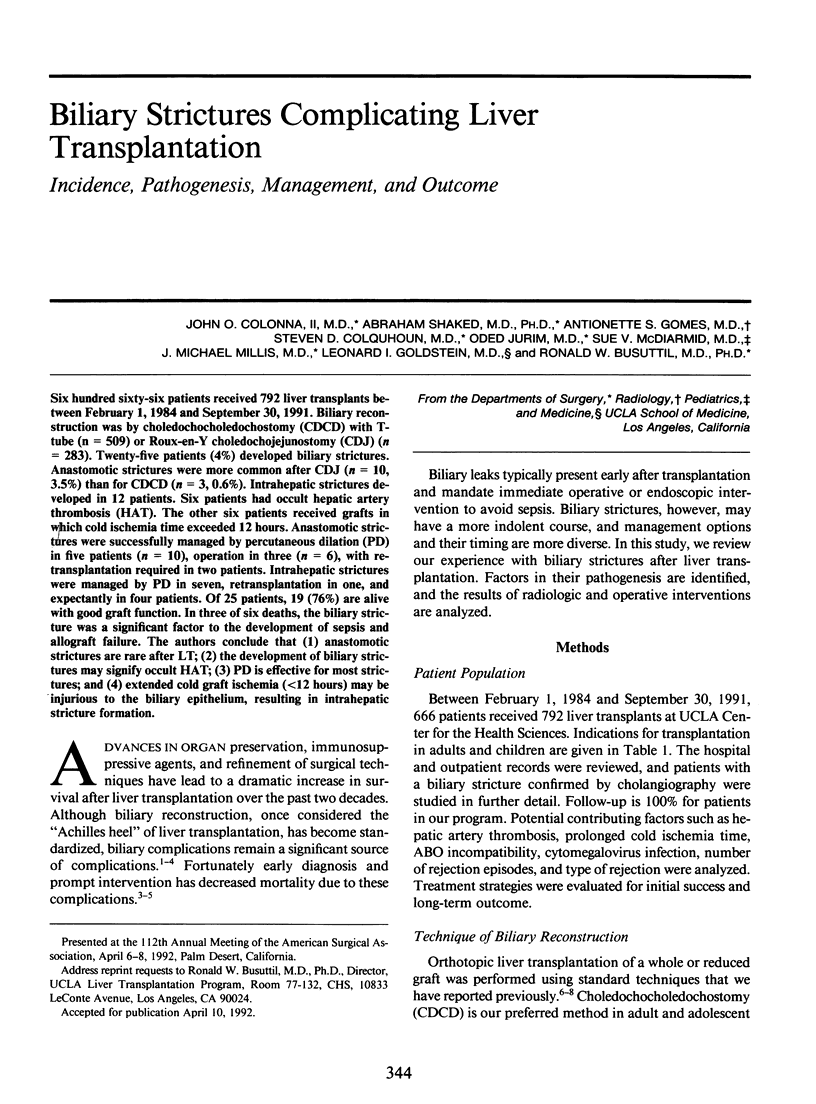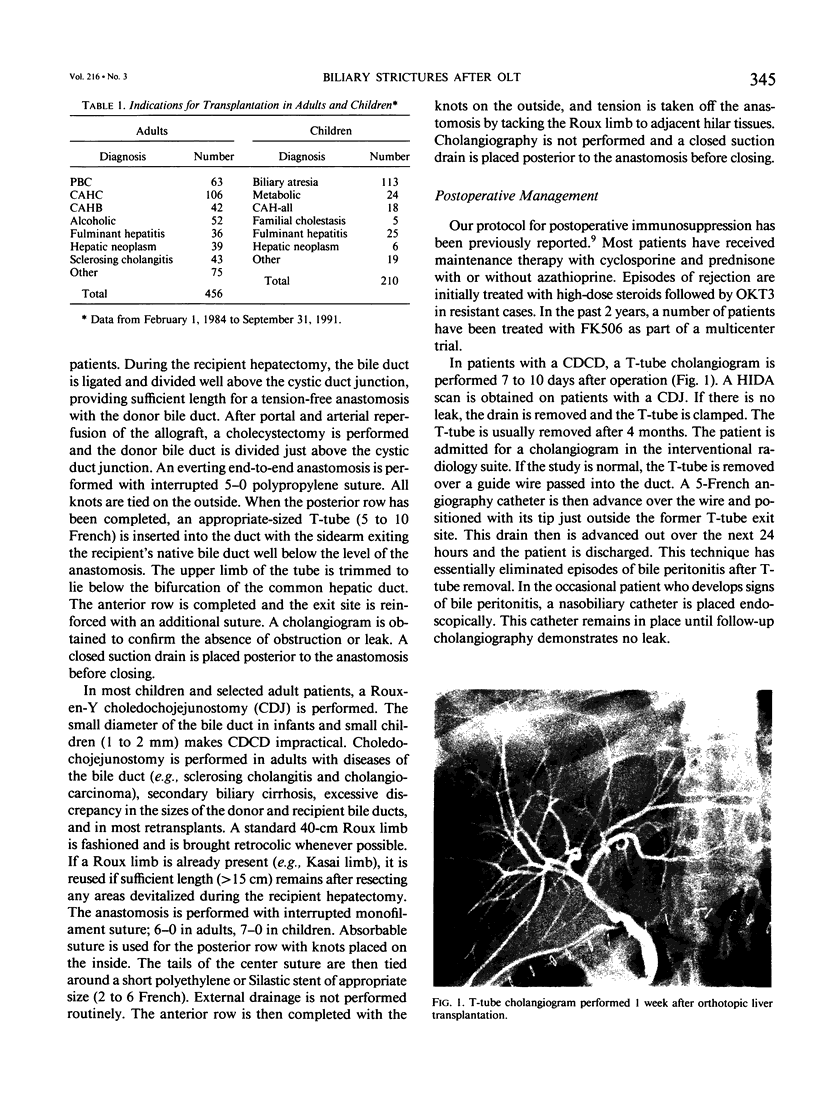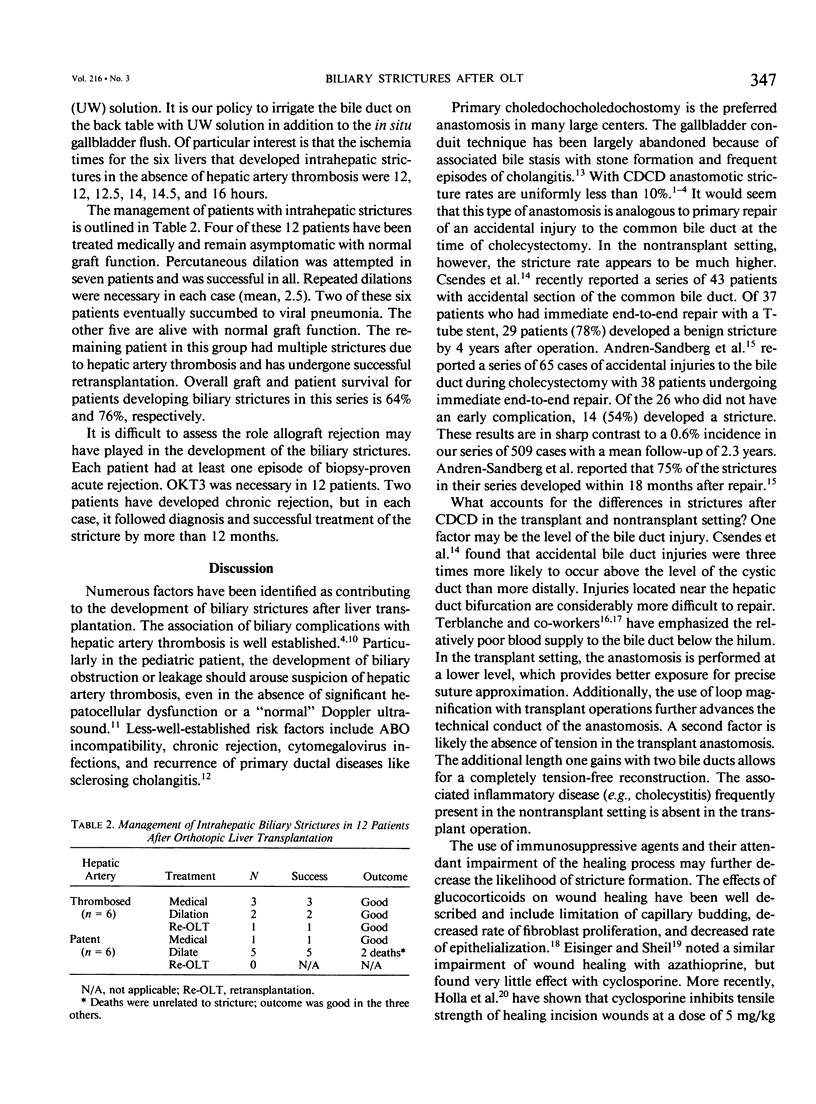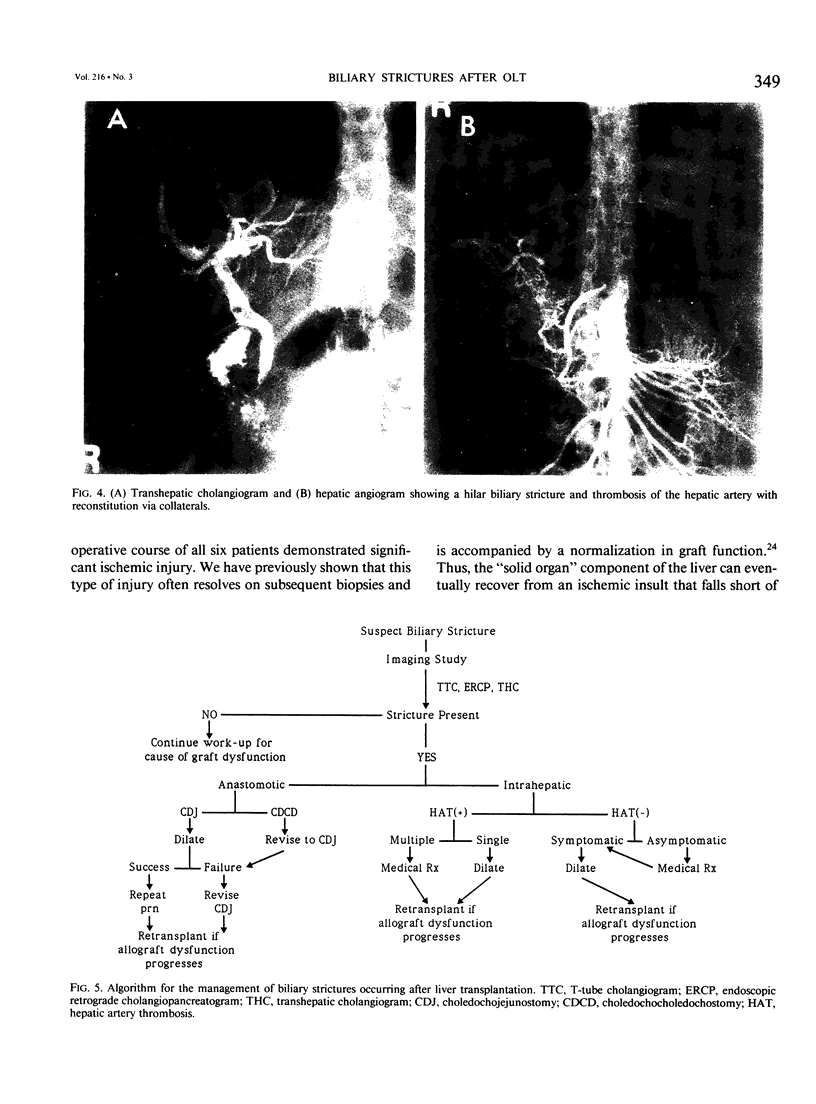Abstract
Six hundred sixty-six patients received 792 liver transplants between February 1, 1984 and September 30, 1991. Biliary reconstruction was by choledochocholedochostomy (CDCD) with T-tube (n = 509) or Roux-en-Y choledochojejunostomy (CDJ) (n = 283). Twenty-five patients (4%) developed biliary strictures. Anastomotic strictures were more common after CDJ (n = 10, 3.5%) than for CDCD (n = 3, 0.6%). Intrahepatic strictures developed in 12 patients. Six patients had occult hepatic artery thrombosis (HAT). The other six patients received grafts in which cold ischemia time exceeded 12 hours. Anastomotic strictures were successfully managed by percutaneous dilation (PD) in five patients (n = 10), operation in three (n = 6), with retransplantation required in two patients. Intrahepatic strictures were managed by PD in seven, retransplantation in one, and expectantly in four patients. Of 25 patients, 19 (76%) are alive with good graft function. In three of six deaths, the biliary stricture was a significant factor to the development of sepsis and allograft failure. The authors conclude that (1) anastomotic strictures are rare after LT; (2) the development of biliary strictures may signify occult HAT; (3) PD is effective for most strictures; and (4) extended cold graft ischemia (less than 12 hours) may be injurious to the biliary epithelium, resulting in intrahepatic stricture formation.
Full text
PDF






Images in this article
Selected References
These references are in PubMed. This may not be the complete list of references from this article.
- Andrén-Sandberg A., Johansson S., Bengmark S. Accidental lesions of the common bile duct at cholecystectomy. II. Results of treatment. Ann Surg. 1985 Apr;201(4):452–455. doi: 10.1097/00000658-198504000-00009. [DOI] [PMC free article] [PubMed] [Google Scholar]
- Busuttil R. W., Colonna J. O., 2nd, Hiatt J. R., Brems J. J., el Khoury G., Goldstein L. I., Quinones-Baldrich W. J., Abdul-Rasool I. H., Ramming K. P. The first 100 liver transplants at UCLA. Ann Surg. 1987 Oct;206(4):387–402. doi: 10.1097/00000658-198710000-00001. [DOI] [PMC free article] [PubMed] [Google Scholar]
- Busuttil R. W., Seu P., Millis J. M., Olthoff K. M., Hiatt J. R., Milewicz A., Nuesse B., el-Khoury G., Raybould D., Nyerges A. Liver transplantation in children. Ann Surg. 1991 Jan;213(1):48–57. doi: 10.1097/00000658-199101000-00009. [DOI] [PMC free article] [PubMed] [Google Scholar]
- Csendes A., Díaz J. C., Burdiles P., Maluenda F. Late results of immediate primary end to end repair in accidental section of the common bile duct. Surg Gynecol Obstet. 1989 Feb;168(2):125–130. [PubMed] [Google Scholar]
- Ehrlich H. P., Hunt T. K. Effects of cortisone and vitamin A on wound healing. Ann Surg. 1968 Mar;167(3):324–328. doi: 10.1097/00000658-196803000-00004. [DOI] [PMC free article] [PubMed] [Google Scholar]
- Eisinger D. R., Sheil A. G. A comparison of the effects of cyclosporin A and standard agents on primary wound healing in the rat. Surg Gynecol Obstet. 1985 Feb;160(2):135–138. [PubMed] [Google Scholar]
- Halff G., Todo S., Hall R., Starzl T. E. Late complications with gallbladder conduit biliary reconstruction after liver transplantation. Transplantation. 1989 Sep;48(3):537–539. doi: 10.1097/00007890-198909000-00044. [DOI] [PMC free article] [PubMed] [Google Scholar]
- Hiatt J. R., Quinones-Baldrich W. J., Ramming K. P., Brems J., Busuttil R. W. Operations upon the biliary tract during transplantation of the liver. Surg Gynecol Obstet. 1987 Jul;165(1):89–93. [PubMed] [Google Scholar]
- Holla R. K., Sequeira R. P., Kulkarni D. Cyclosporine and wound healing: differential effects on tensile strength, granuloma weight, wound contraction and epithelization period in rats. Indian J Exp Biol. 1988 Nov;26(11):869–873. [PubMed] [Google Scholar]
- Imagawa D. K., Strange S. M., Shaked A., Seu P., Colonna J. O., Farmer D., McDiramid S. V., Morrissey M. P., Busuttil R. W. Liver transplantation at UCLA: report of clinical activities. Clin Transpl. 1991:127–134. [PubMed] [Google Scholar]
- Krom R. A., Kingma L. M., Haagsma E. B., Wesenhagen H., Slooff M. J., Gips C. H. Choledochocholedochostomy, a relatively safe procedure in orthotopic liver transplantation. Surgery. 1985 May;97(5):552–556. [PubMed] [Google Scholar]
- Lerut J., Gordon R. D., Iwatsuki S., Esquivel C. O., Todo S., Tzakis A., Starzl T. E. Biliary tract complications in human orthotopic liver transplantation. Transplantation. 1987 Jan;43(1):47–51. doi: 10.1097/00007890-198701000-00011. [DOI] [PMC free article] [PubMed] [Google Scholar]
- Letourneau J. G., Hunter D. W., Payne W. D., Day D. L. Pictorial essay. Imaging of and intervention for biliary complications after hepatic transplantation. AJR Am J Roentgenol. 1990 Apr;154(4):729–733. doi: 10.2214/ajr.154.4.2107666. [DOI] [PubMed] [Google Scholar]
- McDiarmid S. V., Hall T. R., Grant E. G., Milewicz A. L., Olthoff K., Lois J., Vargas J., Ament M. E., Busuttil R. W. Failure of duplex sonography to diagnose hepatic artery thrombosis in a high-risk group of pediatric liver transplant recipients. J Pediatr Surg. 1991 Jun;26(6):710–713. doi: 10.1016/0022-3468(91)90016-m. [DOI] [PubMed] [Google Scholar]
- Northover J. M., Terblanche J. A new look at the arterial supply of the bile duct in man and its surgical implications. Br J Surg. 1979 Jun;66(6):379–384. doi: 10.1002/bjs.1800660603. [DOI] [PubMed] [Google Scholar]
- Ray R. A., Lewin K. J., Colonna J., Goldstein L. I., Busuttil R. W. The role of liver biopsy in evaluating acute allograft dysfunction following liver transplantation: a clinical histologic correlation of 34 liver transplants. Hum Pathol. 1988 Jul;19(7):835–848. doi: 10.1016/s0046-8177(88)80268-5. [DOI] [PubMed] [Google Scholar]
- Recker F., Marquardt K., Redha F., Uhlschmid G., Largiadèr F. Cyclosporine A impairs wound healing of ureterocystoneostomy in rats. Scanning electron microscopic examination. Urol Res. 1989;17(1):21–26. doi: 10.1007/BF00261043. [DOI] [PubMed] [Google Scholar]
- Shaked A., Busuttil R. W. Liver transplantation in patients with portal vein thrombosis and central portacaval shunts. Ann Surg. 1991 Dec;214(6):696–702. doi: 10.1097/00000658-199112000-00009. [DOI] [PMC free article] [PubMed] [Google Scholar]
- Stratta R. J., Wood R. P., Langnas A. N., Hollins R. R., Bruder K. J., Donovan J. P., Burnett D. A., Lieberman R. P., Lund G. B., Pillen T. J. Diagnosis and treatment of biliary tract complications after orthotopic liver transplantation. Surgery. 1989 Oct;106(4):675–684. [PubMed] [Google Scholar]
- Terblanche J., Worthley C. S., Spence R. A., Krige J. E. High or low hepaticojejunostomy for bile duct strictures? Surgery. 1990 Nov;108(5):828–834. [PubMed] [Google Scholar]
- Tzakis A. G., Gordon R. D., Shaw B. W., Jr, Iwatsuki S., Starzl T. E. Clinical presentation of hepatic artery thrombosis after liver transplantation in the cyclosporine era. Transplantation. 1985 Dec;40(6):667–671. doi: 10.1097/00007890-198512000-00019. [DOI] [PMC free article] [PubMed] [Google Scholar]
- Ward E. M., Kiely M. J., Maus T. P., Wiesner R. H., Krom R. A. Hilar biliary strictures after liver transplantation: cholangiography and percutaneous treatment. Radiology. 1990 Oct;177(1):259–263. doi: 10.1148/radiology.177.1.2399328. [DOI] [PubMed] [Google Scholar]
- Zajko A. B., Campbell W. L., Logsdon G. A., Bron K. M., Tzakis A., Esquivel C. O., Starzl T. E. Cholangiographic findings in hepatic artery occlusion after liver transplantation. AJR Am J Roentgenol. 1987 Sep;149(3):485–489. doi: 10.2214/ajr.149.3.485. [DOI] [PMC free article] [PubMed] [Google Scholar]






